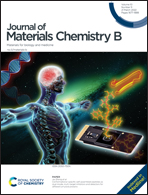Heparinized anticoagulant coatings based on polyphenol-amine inspired chemistry for blood-contacting catheters†
Abstract
Blood-contacting catheters occupy a vital position in modern clinical treatment including but not limited to cardiovascular diseases, but catheter-related thrombosis associated with high morbidity and mortality remains a major health concern. Hence, there is an urgent need for functionalized catheter surfaces with superior hemocompatibility that prevent protein adsorption and thrombus formation. In this work, we developed a strategy for constructing a kind of polyphenol-amine coating on the TPU surface (TLA) with tannic acid and lysine via simple dip-coating, inspired by dopamine adhesion. Based on the long-term stability and modifiable properties of TLA coatings, heparin was introduced by an amide reaction to provide anticoagulant activity (TLH). X-ray photoelectron spectroscopy and surface zeta potential measurements fully indicated the successful immobilization of heparin. Water contact angle measurements demonstrated good hydrophilicity and stability for 15 days of TLH coatings. Furthermore, the TLH coatings exhibited significant hemocompatibility and no cytotoxicity. The good antithrombotic properties of the functionalized surfaces were confirmed by an ex vivo blood circulation model. The present work is supposed to find potential clinical applications for preventing surface-induced thrombosis of blood-contacting catheters.



 Please wait while we load your content...
Please wait while we load your content...